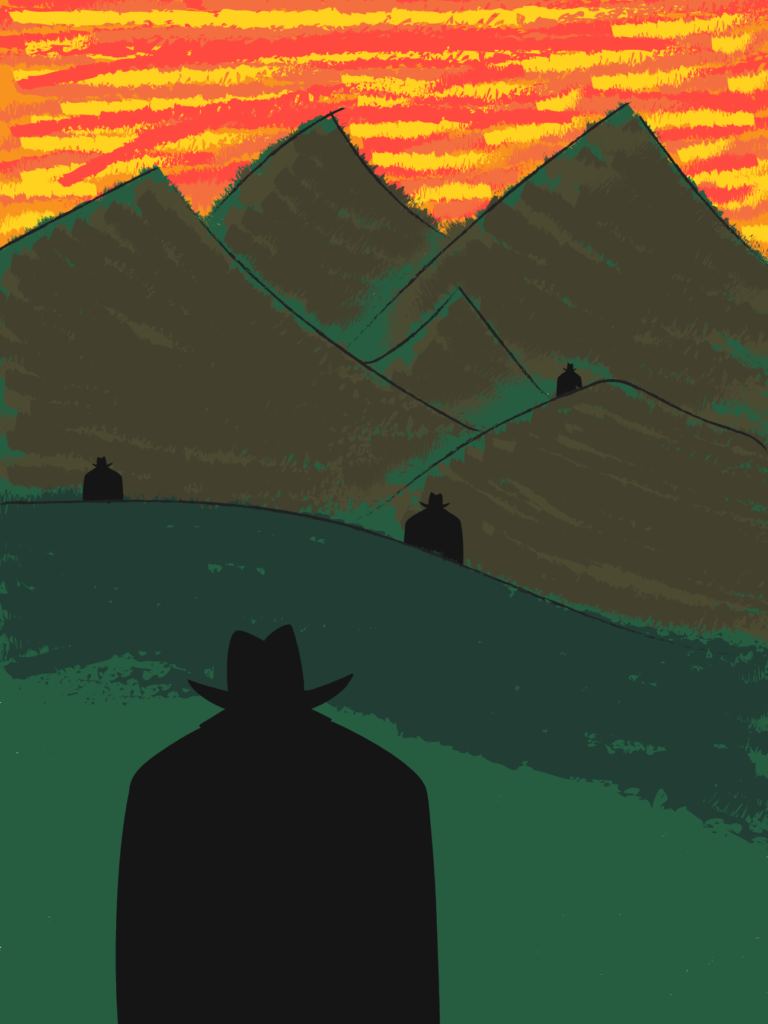
There are animals which lurk in the shadows.
There are people who lurk in the shadows.
But what can be done when the shadows are the ones who lurk around us?
Hidden among the forestry of hilltops and rocky shores, the Dark Watchers loom over humanity, casting their judging eyes upon passersby.
The Dark Watchers are entities unlike no other.
These tall figures cloaked in shadow have never been reported to be seen up close, always keeping their distance from whomever they have directed their attention to.
The Watchers are reported to be seen primarily in the Californian region of Big Sur, home to the Santa Lucia Mountains.
Because of their elusive nature, descriptions of these figures are muddy at best, but there are three things each witness can agree on.
The Dark Watchers are tall, humanoid figures draped in a cloak or trench coat who wear large wide-brimmed hats, are completely enveloped in shadow to leave any distinguishing features veiled and sometimes are seen holding a staff or walking stick.
The Watchers are seen in the hours of twilight as the sun begins to peer over the mountains.
But there is one last attribute that reports agree upon.
What the Watchers want is unsure.
Do they even want something?
Reports of the Dark Watchers are said to be traced back to early paintings and stories from the Chumash people of Central California.
Despite these claims, there is little information to corroborate them other than tales of the nunašīš, shapeshifting beings of bad luck, detailed in Chumash stories collected by ethnologist John Peabody Harrington.
The first documented reports of the Dark Watchers date back to early Spanish colonization of California.
Known to Spanish settlers as Los Vigilantes Oscuros, the figures were thought to be supernatural watchmen who were present to benevolently oversee the progress of the Spanish settlements.
Los Vigilantes Oscuros became figures of legend passed down through generations of the Spanish inhabitants of California, with the tales being told to Americans as the country expanded westward.
The legend of the Dark Watchers eventually faded into the background as California became the site of the Mexican-American War for annexation of California.
It wouldn’t be until 1937 when American poet Robinson Jeffers wrote his poem “Such Counsels You Gave to Me” that the Watchers would return to the eye of the Californian public.
Jeffers wrote, “He thought it might be one of the watchers, / Who are often seen in this length of coast-range, forms that look human / To human eyes, but are certainly not human. / They come from behind ridges and watch.”
A year later, another notable Californian poet, John Steinbeck, would mention figures similar to the Dark Watchers in his piece “Flight.”
However, while the Dark Watchers are sighted primarily in Big Sur, there are reports of similar figures appearing in other mountain regions of the world.
Scotland’s Am Fear Liath Mòr of Ben MacDhui or the Grey Man of Ben MacDhui is a humanoid figure said to inhabit the summit of the mountain Ben MacDhui.
Unlike the Dark Watchers, though, descriptions of the Grey Man vary greatly.
Some witnesses describe the Grey Man to more closely something along the lines of the Yeti or Bigfoot, while others give descriptions of a clothed humanoid similar to the California Watchers.
Other sightings of similar figures have appeared in the Alps, the Andes and Australia’s Great Dividing Range.
The Dark Watchers also harken back to legends and myths about Shadow People, mysterious beings that lurk in the corners of our vision, always just barely out of sight.
While similar though, Shadow People are often attributed to phenomena more commonly experienced within a house, primarily during sleep paralysis.
During a bout of sleep paralysis, a person’s body stays asleep while their brain is semi-conscious and their eyes are open. This bizarre experience causes the brain to panic and create hallucinations and illusions, often of otherworldly beings looming over the paralyzed sleeper.
One particular shadow person that has been reported in multiple sleep paralysis cases is the “Hat Man,” a tall, looming figure who wears a large hat, often accompanied by some sort of robe or trench coat, not unlike the Dark Watchers.
There are two prominent theories that would point toward some sort of explanation for the presence of these mysterious Watchers, both of them based upon the regional topography of areas where the Watchers are sighted.
A Brocken specter or mountain specter is an amplified version of a shadow cast on nearby clouds or fog when the sun is opposite the cloud.
This amplified shadow appears to have elongated, gigantic proportions and is often projected a substantial distance away from the shadow’s origins.
As the Dark Watchers are often seen near twilight, when the sun could be positioned behind witnesses while morning fog rolls in, it is more than possible the Watchers are nothing more than the shadows of the witnesses being projected upon the mountaintops.
The other theory relies on similar grounds of optical illusions, but on a more psychological level.
Infrasound is a low-frequency sound below the audible range of 20 Hz and can have physical and psychological effects on nearby humans.
Paranoia, anxiety, insomnia and panic are common symptoms in people who have been exposed to an infrasound.
If a person is close enough to the origin point, infrasound can even cause the eyes to vibrate and create visual hallucinations.
Interestingly enough, infrasound is most commonly reported to be caused by nearby ocean waves or wind passing through mountain ranges, two elements of the environments the Dark Watchers and their kin are often spotted by.
Whether supernatural or phenomenological, the Watchers live on in very real stories that have been passed down for generations.
Humans have always been paranoid of being watched, even by each other. Perhaps the Dark Watchers are what initially instilled that fear in ancient man.

